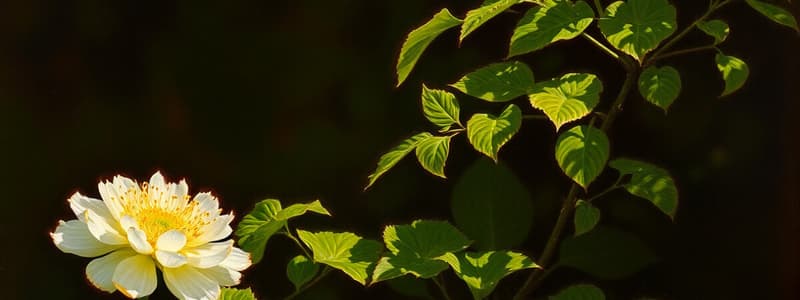Podcast
Questions and Answers
What is the primary location for photosynthesis in a leaf?
What is the primary location for photosynthesis in a leaf?
- Chloroplasts (correct)
- Stomata
- Phloem
- Xylem
What is the function of stomata in leaves?
What is the function of stomata in leaves?
- Facilitate gas exchange (correct)
- Store water
- Conduct photosynthesis
- Transport nutrients
Which cells in leaves contain chloroplasts?
Which cells in leaves contain chloroplasts?
- Bundle sheath cells
- Mesophyll cells (correct)
- Guard cells
- Epidermal cells
What gas do plants take in through the stomata for photosynthesis?
What gas do plants take in through the stomata for photosynthesis?
Which of the following correctly describes mesophyll cells?
Which of the following correctly describes mesophyll cells?
What byproducts are released during photosynthesis?
What byproducts are released during photosynthesis?
What is the primary role of chloroplasts in mesophyll cells?
What is the primary role of chloroplasts in mesophyll cells?
Which of the following statements about chloroplasts is true?
Which of the following statements about chloroplasts is true?
Which type of radiation has the shortest wavelength in the electromagnetic spectrum?
Which type of radiation has the shortest wavelength in the electromagnetic spectrum?
What color of visible light corresponds to a wavelength of approximately 500 nanometers?
What color of visible light corresponds to a wavelength of approximately 500 nanometers?
Which type of radiation is primarily absorbed by the Earth's surface?
Which type of radiation is primarily absorbed by the Earth's surface?
Which of the following types of electromagnetic radiation has the longest wavelength?
Which of the following types of electromagnetic radiation has the longest wavelength?
What is the order of visible light colors from shortest to longest wavelength?
What is the order of visible light colors from shortest to longest wavelength?
What type of radiation is invisible to the human eye but has wavelengths shorter than visible light?
What type of radiation is invisible to the human eye but has wavelengths shorter than visible light?
Which of the following ranges of wavelengths is considered to be ultraviolet radiation?
Which of the following ranges of wavelengths is considered to be ultraviolet radiation?
What is the primary type of radiation emitted by the Sun that reaches the Earth's surface?
What is the primary type of radiation emitted by the Sun that reaches the Earth's surface?
What structures within the chloroplasts are responsible for photosynthesis?
What structures within the chloroplasts are responsible for photosynthesis?
Which of the following components is NOT found in a chloroplast?
Which of the following components is NOT found in a chloroplast?
What is the primary function of the stroma in chloroplasts?
What is the primary function of the stroma in chloroplasts?
What is the role of the thylakoids within the chloroplast?
What is the role of the thylakoids within the chloroplast?
Which part of the chloroplast contains the chlorophyll necessary for photosynthesis?
Which part of the chloroplast contains the chlorophyll necessary for photosynthesis?
What is primarily produced by photosynthetic organisms that is essential for aerobic life?
What is primarily produced by photosynthetic organisms that is essential for aerobic life?
Which process allows organisms to create their own food using sunlight?
Which process allows organisms to create their own food using sunlight?
Which statement about heterotrophs is true regarding photosynthesis?
Which statement about heterotrophs is true regarding photosynthesis?
Why might photosynthesis be considered a crucial evolutionary development?
Why might photosynthesis be considered a crucial evolutionary development?
What essential molecule is utilized during the process of photosynthesis?
What essential molecule is utilized during the process of photosynthesis?
Which of the following is a byproduct of photosynthesis?
Which of the following is a byproduct of photosynthesis?
What is the primary energy source for the process of photosynthesis?
What is the primary energy source for the process of photosynthesis?
Which of the following wavelengths of light is most effective for photosynthesis?
Which of the following wavelengths of light is most effective for photosynthesis?
How do photosynthetic organisms impact the carbon cycle?
How do photosynthetic organisms impact the carbon cycle?
Which of the following is a direct consequence of photosynthesis in the ecosystem?
Which of the following is a direct consequence of photosynthesis in the ecosystem?
Which type of plants are more likely to use the CAM pathway for carbon fixation?
Which type of plants are more likely to use the CAM pathway for carbon fixation?
In which part of the plant does the Calvin cycle take place?
In which part of the plant does the Calvin cycle take place?
How does the CAM pathway differ from the C4 pathway?
How does the CAM pathway differ from the C4 pathway?
What is a common characteristic of plants that utilize the C4 pathway?
What is a common characteristic of plants that utilize the C4 pathway?
What anatomical feature is essential for the functioning of the CAM pathway?
What anatomical feature is essential for the functioning of the CAM pathway?
Why is the Calvin cycle important for plants?
Why is the Calvin cycle important for plants?
Which pathway would a plant in a humid environment likely prefer?
Which pathway would a plant in a humid environment likely prefer?
What primary advantage does the C4 pathway offer to plants?
What primary advantage does the C4 pathway offer to plants?
Flashcards are hidden until you start studying
Study Notes
Photosynthesis and Life
- Photosynthesis is crucial for sustaining life on Earth.
- Photosynthetic organisms produce oxygen and make their own food, sustaining themselves and other organisms.
Sun's Energy
- The sun releases energy in various wavelengths, including visible light.
- Visible light is perceived as colors, ranging from violet to red.
Photosynthesis in Chloroplasts
- Photosynthesis occurs in chloroplasts, found in mesophyll cells inside leaves.
- Chloroplasts contain stacks of thylakoids called grana, which are involved in the light-dependent reactions of photosynthesis.
Carbon Fixation Pathways
- Plants utilize different carbon fixation pathways, including C3, C4, and CAM pathways.
- C4 pathway occurs in plants adapted to hot, dry environments, reducing photorespiration to conserve water.
- CAM pathway occurs in succulent plants like cacti, allowing them to absorb carbon dioxide at night and fix it during the day to conserve water.
Studying That Suits You
Use AI to generate personalized quizzes and flashcards to suit your learning preferences.




